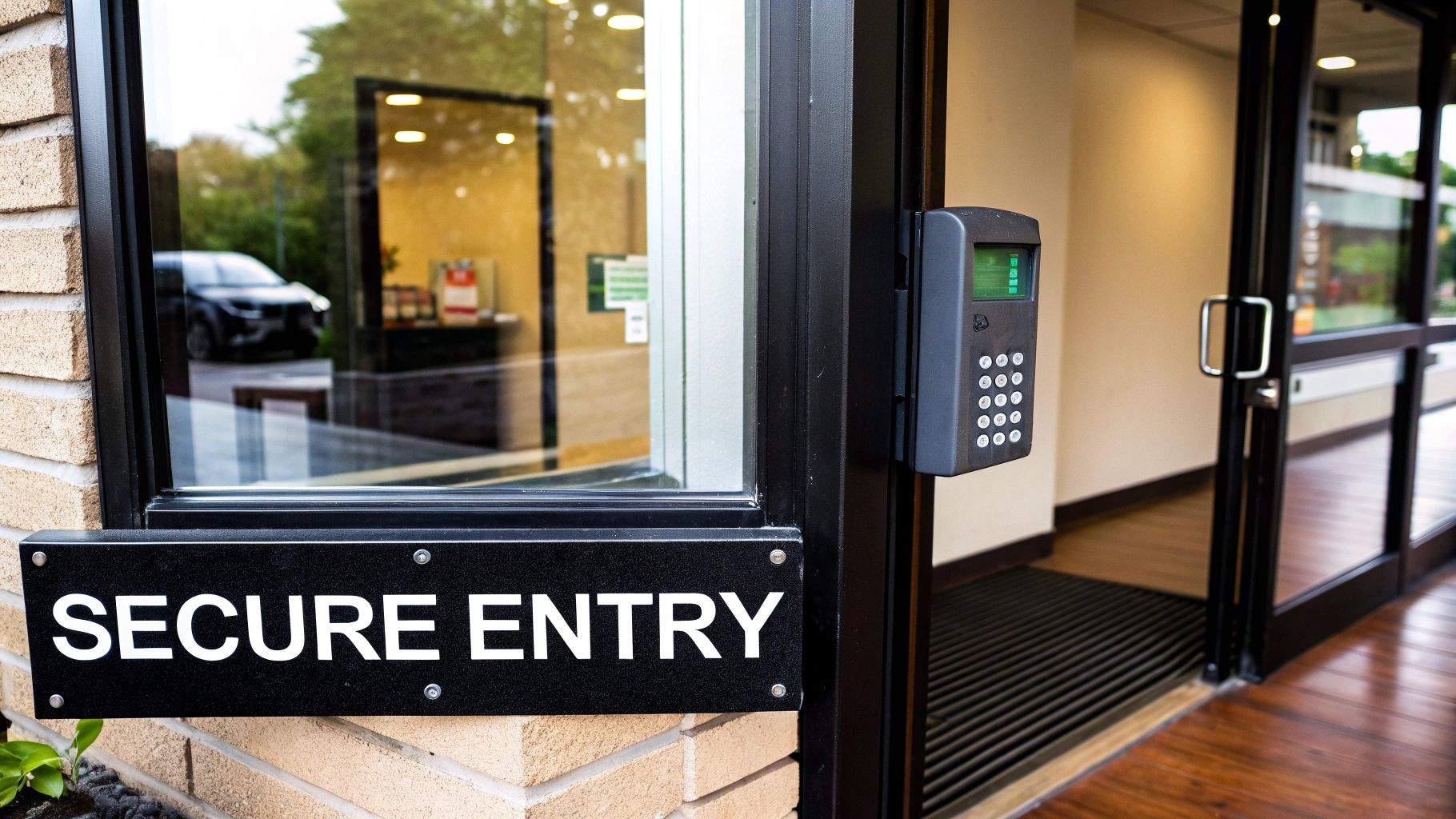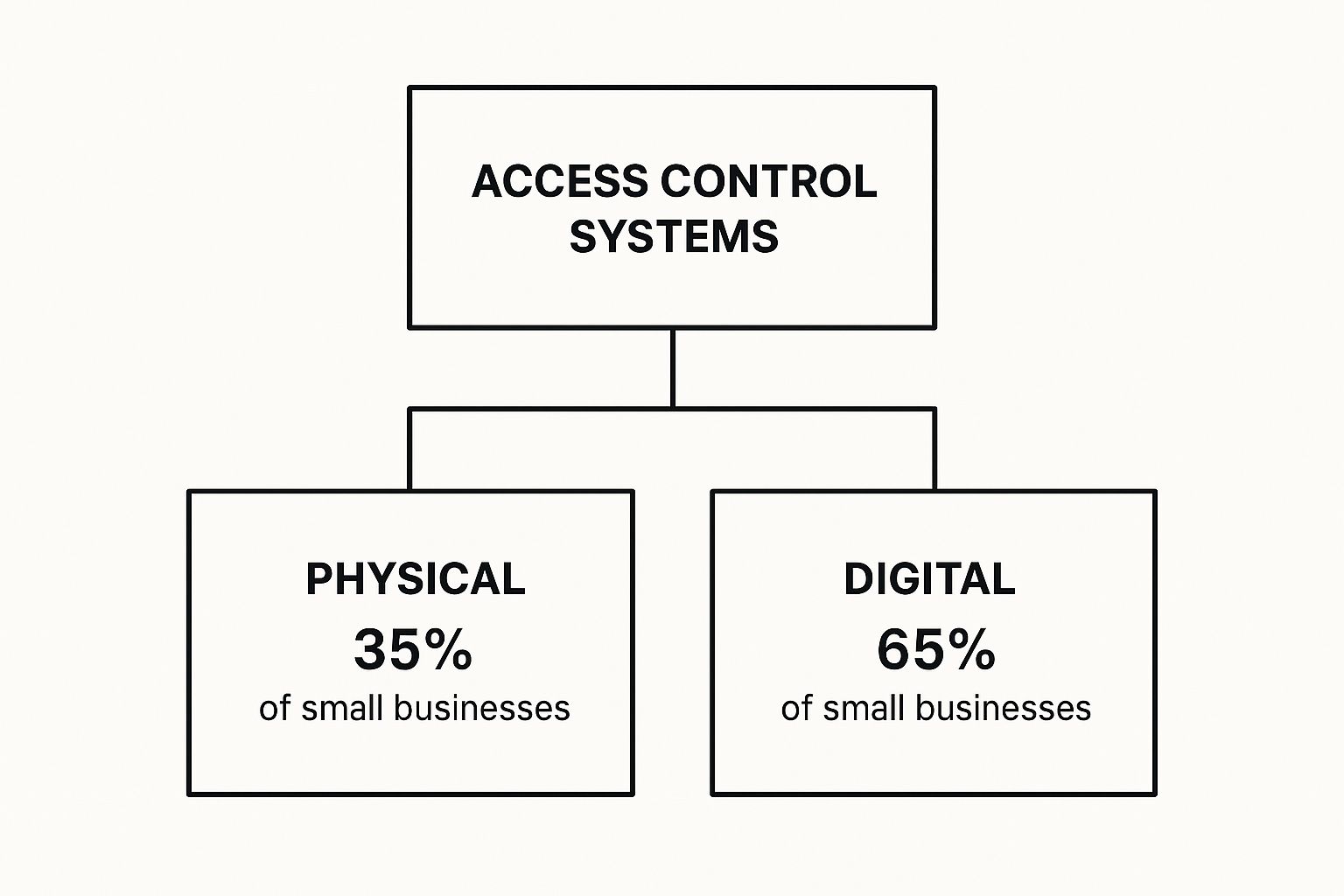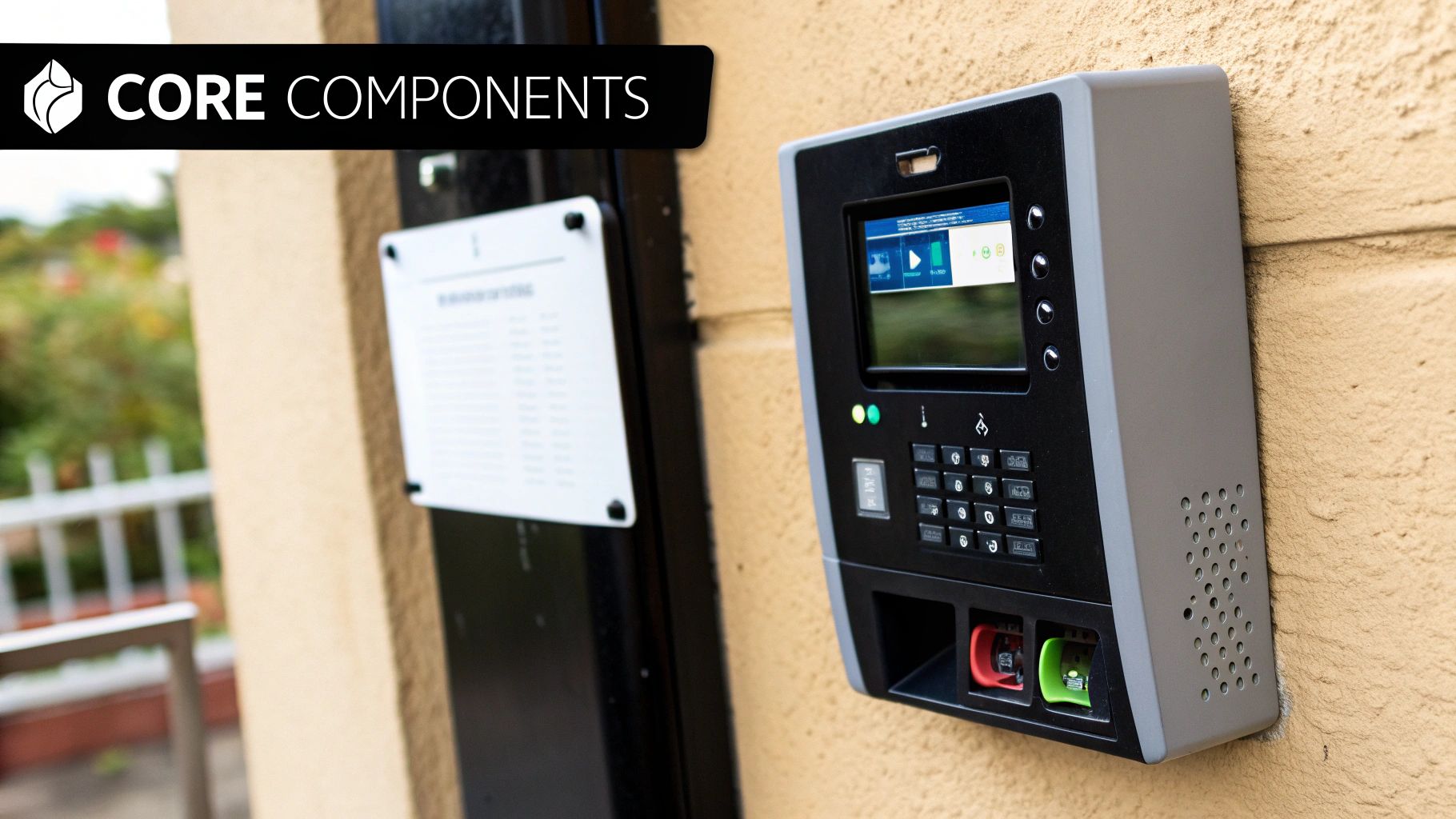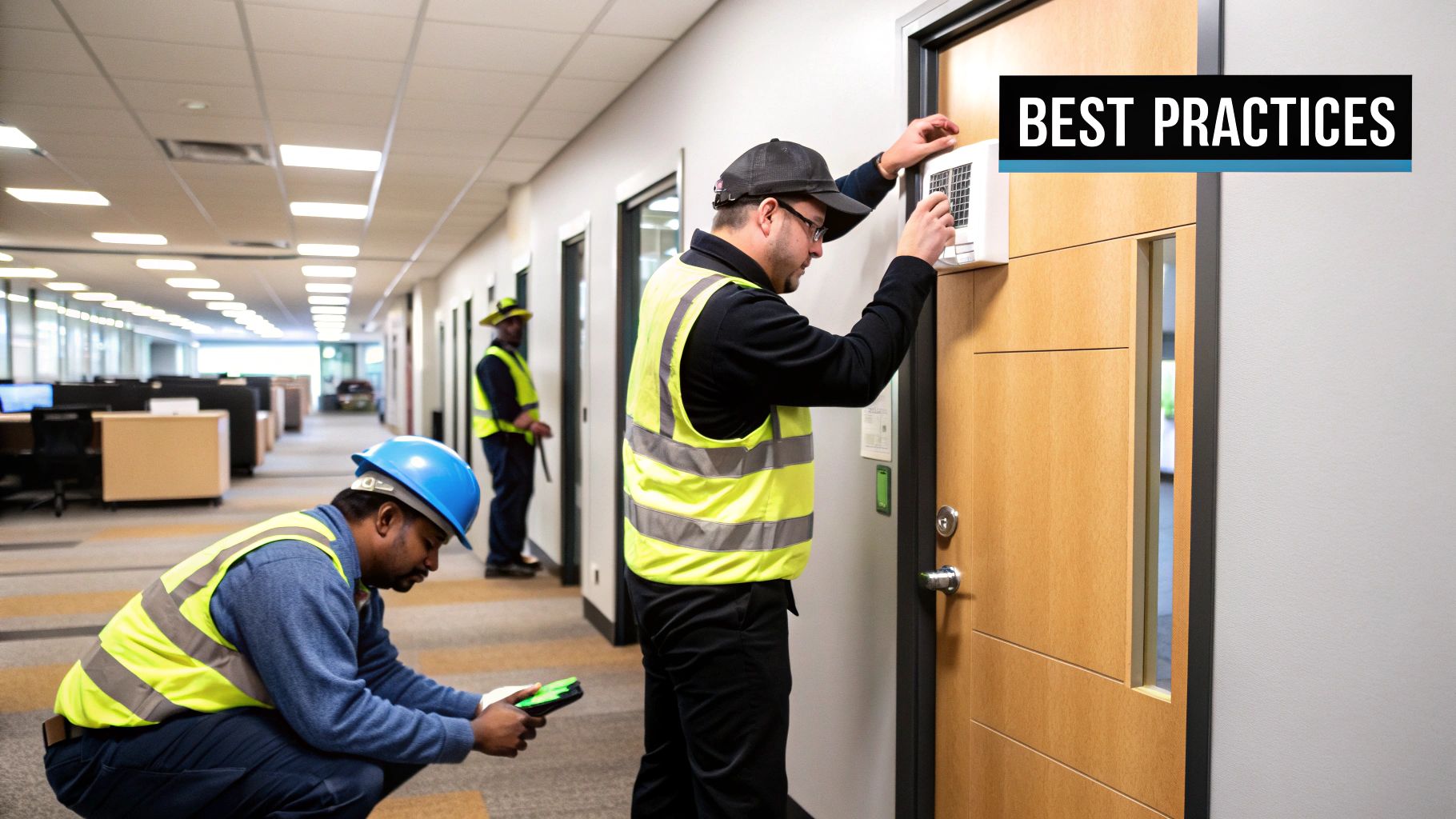Access Control Systems for Small Business
- Бонус за регистрацию онлайн казино
- 20 hours ago
- 13 min read
At its core, an access control system for your small business is a modern way to manage who can go where on your property. Forget the old-fashioned lock and key. We're talking about a digital gatekeeper that uses key cards, PINs, or even smartphone apps to grant access.
Why Modern Access Control Is a Smart Move

For a long time, sophisticated security felt out of reach for anyone but large corporations with deep pockets. That's simply not true anymore. The same smart, user-friendly tech you might have protecting your home is now perfectly scaled and priced for businesses of all sizes.
Think about it: what happens when an employee loses a key? You're stuck calling a locksmith and re-keying the whole office. With a modern access control system, you can just log into a dashboard and deactivate that person's credential in seconds. It's a fundamental shift from clunky physical keys to flexible digital access, making your business safer and easier to manage.
Protecting More Than Just Your Front Door
Keeping the main entrance secure is just the start. The real value of these systems lies in protecting your most critical assets—and that includes more than just inventory or equipment. We're also talking about the sensitive data on your servers and computers.
Unauthorized physical access is a huge, and often underestimated, security risk. In fact, some of the top cybersecurity mistakes businesses make are related to not securing the physical environment where their data lives. Controlling who can walk into the server room or a records closet is every bit as important as securing the front door.
A well-planned access control system is your first line of defense. It creates a secure physical perimeter that protects your tangible property and your digital infrastructure from both internal and external threats.
An Investment in Efficiency and Peace of Mind
Beyond just locking doors, these systems bring some serious operational advantages to the table. They create a clear, undeniable audit trail, logging exactly who entered a specific area and when. This kind of data is gold if you ever need to investigate an incident and helps build a culture of accountability.
Here's what you really gain by implementing an access control system:
Enhanced Security: It’s a powerful deterrent, protecting your physical assets and sensitive information from theft or unauthorized viewing.
Operational Efficiency: Say goodbye to the cost and headache of replacing lost keys and rekeying locks every time an employee leaves.
A Scalable Solution: A good system grows with you. You can start with a single door and expand to multiple locations without having to rip everything out and start over.
Improved Employee Safety: Knowing that only authorized people can get into the building creates a much safer and more comfortable work environment for everyone.
Ultimately, investing in access control systems for a small business isn't just another security expense. It's a strategic move toward running a more professional, controlled, and resilient company.
Understanding Your Access Control Options
Diving into access control can seem like a lot to take on, but don't worry—the core ideas are pretty straightforward. Once you get the hang of the basics, you'll know exactly what your small business needs. Think of it like deciding who gets a key to your house and which doors that key opens.
The visual below breaks down the two main types of systems small businesses are using today. It's clear that digital is quickly becoming the new standard.

This shift is significant. In fact, 65% of small businesses now choose digital systems over old-school physical ones. Why? Because they offer far more flexibility and control.
Core Access Control Models
On a fundamental level, access control systems operate using one of three main models. Each one gives you a different degree of control, kind of like having a simple key, a master key, or a high-security key.
Discretionary Access Control (DAC): This is the most flexible and basic model. It's like giving your house key to a trusted friend—you've given them the power to enter, and they can decide to let others in, too. In a business context, the owner or a manager can grant permissions to anyone as they see fit. It’s simple, but not very granular.
Mandatory Access Control (MAC): Think of this as the Fort Knox of access control. It’s the most restrictive and secure option, where access is dictated by strict, system-wide rules and clearance levels—not by an individual's choice. This is overkill for most small businesses unless you're handling incredibly sensitive data.
Role-Based Access Control (RBAC): Here’s the sweet spot for most businesses. RBAC grants access based on a person’s job function or "role." A manager's keycard might open their office, the server room, and the supply closet. An employee’s card, on the other hand, might only grant access to the main entrance. This strikes the perfect balance between practical security and day-to-day usability.
Exploring the Hardware Options
The control model you pick is the "brain" of your system, but you still need the physical "hands" to actually lock and unlock the doors. This is where hardware comes in. For businesses looking to move beyond traditional keys, checking out modern digital locks is a great first step to see what's possible with keyless entry.
These systems are no longer a luxury; they're becoming a critical layer of defense. The market for electronic access control is projected to hit $55.1 billion by 2034, fueled by growing security needs.
Your choice of hardware directly impacts your team's daily experience. The best system is one that blends robust security with effortless convenience, making sure protection doesn't get in the way of productivity.
Here’s a look at the most common hardware choices and how they stack up for a small business.
Comparing Access Control Hardware for Small Businesses
This table breaks down the common hardware types, helping you weigh the pros and cons based on what matters most for your operation.
Hardware Type | Best For | Security Level | Typical Cost | Convenience |
|---|---|---|---|---|
Keypad Locks | Low-traffic areas; simplicity | Low to Medium | $ | High |
Card & Fob Readers | Most office environments | Medium | $$ | High |
Biometric Scanners | High-security zones; convenience | High | $$$ | Very High |
Smartphone/Mobile | Tech-savvy teams; remote access | Medium to High | $$ | Very High |
As you can see, there's a trade-off between cost, security, and convenience. The right choice depends entirely on your specific needs, budget, and how your team works. A simple keypad might be perfect for a supply closet, while a biometric scanner could be the right call for your server room.
The Everyday Benefits Beyond Basic Security

A good access control system is about so much more than just keeping the wrong people out. Once you have one in place, you'll find it quickly becomes a core part of how you run your business day-to-day. The most obvious win? You can finally say goodbye to the endless headaches that come with traditional metal keys.
Think about it. When an employee leaves, there’s no more scrambling to call a locksmith or wondering how many copies of that key are floating around. You just log into a dashboard and deactivate their card or fob. It takes seconds.
This digital approach also gives you a powerful audit trail. Every time someone uses their credential, the system logs who it was, where they went, and exactly when. This isn't just for investigating a major security breach; it's handy for everyday things, like figuring out who was last in the supply closet or tracking down a missing tool. It naturally builds a sense of accountability.
Streamlining Your Daily Operations
The real magic happens when you realize how much smoother your daily tasks can become. Modern access control systems for a small business aren't just standalone security gadgets; they can work in tandem with the other tools you already use.
Simplified Payroll: Many systems can link directly with time and attendance software. An employee badges in at the front door, and their start time is automatically logged for payroll. This cuts down on manual data entry and all but eliminates "buddy punching."
Seamless Visitor Management: Ditch the messy paper sign-in book at the front desk. You can issue temporary digital keys, QR codes, or PINs to visitors that only work for specific areas and times. It looks far more professional and dramatically tightens up security.
Enhanced Employee Safety: Your team can't do their best work if they don't feel safe. Simply knowing that only authorized people can get into the building provides a fundamental sense of security that is invaluable for morale and focus.
This push for smarter, more integrated security is why the global access control market is booming. It's expected to jump from $9.9 billion in 2024 to $14.26 billion by 2029. This isn't just big corporations driving the trend; it's small businesses realizing these systems are essential for protecting their assets. You can explore more insights on the global access control market if you're curious about the trends.
A Scalable Foundation for Growth
Perhaps the most underrated benefit is how these systems grow with you. When you expand—whether it's leasing a new office, adding a warehouse, or just securing a new server room—your security can scale effortlessly.
Think of your access control system as a scalable framework. You can start with one door and methodically expand to multiple locations, all managed from the same central platform. This protects your initial investment and ensures your security infrastructure keeps pace with your success.
Finally, don't overlook the potential financial perks. Many insurance companies see a professionally installed access control system as a serious commitment to reducing risk. As a result, they may offer you lower premiums on your business insurance, providing a direct return on your investment. It’s one more way that modern access control proves it’s not just a cost, but a smart business decision.
How to Choose the Right System for Your Business
Picking the right access control system isn't about buying the most expensive gear on the shelf. It’s about making a smart investment that actually solves your problems—both today and as your business grows. Think of this as your practical guide to finding the perfect fit.
The first step has nothing to do with technology. It's a simple self-assessment. Before you even glance at a product, you need to get crystal clear on what you’re trying to accomplish. This is your security blueprint, and getting it right prevents you from overpaying for features you’ll never use or, worse, under-spending and leaving your business exposed.
The best access control systems for small business are never one-size-fits-all. They are carefully chosen tools that fix specific issues, whether that's protecting inventory in a stockroom or securing sensitive client files in an office.
Start with These Core Questions
To build that security blueprint, take a few minutes to think through these fundamental questions. Your answers will steer every decision that follows.
What are you protecting? Is it expensive equipment, a server room filled with client data, high-value inventory, or simply creating a safe environment for your team? The nature of your assets dictates how robust your security needs to be.
Who needs access? Make a quick list of every single person who needs to get in. Think beyond your full-time employees—what about part-time staff, cleaning crews, delivery drivers, or temporary contractors?
When and where do they need it? Do your employees need access 24/7, or only from 9 to 5? Should the marketing team be able to just walk into the server room? Defining access zones and schedules is the key to making your system truly effective.
Key Factors to Evaluate
Once you have a clear picture of your needs, you can start weighing your options. Look past the initial price and consider the real-world value and long-term fit for your business.
A huge decision point is whether to go with a cloud-based system or a traditional on-premise one. An on-premise setup keeps all your data on a local server right there in your office, giving you complete physical control. A cloud-based system, on the other hand, stores data remotely and is managed through an app or web browser, which means more flexibility and lower upfront hardware costs. Honestly, for most small businesses, the convenience and scalability of a cloud solution are hard to beat.
The market is certainly heading in that direction. The small and medium-sized business segment for access control is expected to grow at a compound annual growth rate of 12.25% through 2035. This boom is happening because small businesses need to stay nimble, often embracing mobile and biometric solutions much faster than their larger corporate counterparts. You can dig into more North American access control market trends if you're curious.
Finally, remember that an access system is just one piece of your overall security puzzle. While you're choosing a system, take a look at the physical security of all your entry points. For instance, knowing which types of garage doors are the most secure garage doors can seriously strengthen your entire security strategy.
Your Step-by-Step Implementation Plan

Alright, you've chosen a system. Now what? The thought of installing new security hardware can feel a bit overwhelming, but it doesn't have to be. By breaking the process down into a few practical steps, you can get your new access control system up and running smoothly, without causing major headaches for your team or your daily workflow.
Think of it as a simple project plan. The key is to move methodically from the blueprint phase to a fully functional system. And it all starts not with the hardware, but with a good, hard look at your physical space.
Step 1: Conduct a Thorough Site Assessment
Before you even think about ordering equipment, you (or your installer) need to walk the property. This is your security blueprint, and it’s the most critical part of the process. Go through your facility and identify every single door, gate, or entry point you need to secure. We’re talking about everything from the main entrance and delivery bays to the server room and your private office.
As you walk, take detailed notes. What are the doors and frames made of—wood, steel, glass? Where are the nearest power outlets and network jacks? Getting this information upfront is crucial. It dictates what kind of hardware you can use and helps you avoid unexpected installation costs down the road.
Step 2: Choose a Reliable Installer
While some of the simpler, all-in-one systems might seem like a weekend DIY project, most businesses are far better off bringing in a professional. Partnering with an experienced installer like PCI Audio-Video Security Solutions is a smart investment.
An expert does more than just mount a reader on the wall. They make sure the wiring is clean, the hardware is installed to code, and the whole system is reliable. A sloppy installation can actually introduce new security holes, which completely defeats the purpose. When you're looking for an installer, ask if they have experience with businesses your size and with the type of system you've picked out. Don't be shy about asking for references.
A professional installation isn’t just about hanging hardware. It’s about weaving a security system into the very structure of your building so it performs flawlessly for years to come.
Step 3: Configure Users and Set Schedules
With the hardware physically installed, it's time to move to the software. This is where you translate your security plan into digital rules. You’ll start by creating profiles for every employee and assigning them their specific credential—be it a key card, a mobile pass on their phone, or a simple PIN.
This is also where you'll put role-based access control (RBAC) into action. Instead of setting permissions one person at a time, you create groups like "Managers," "Sales Team," or "Warehouse Crew." Then you assign access rules to the group based on what they actually need.
For example:
Managers: Might get 24/7 access to every secured door.
Day-Shift Employees: Can get into the main entrance and their work areas from 8 AM to 6 PM, Monday through Friday.
Cleaning Crew: Can only access specific areas during their shift, say from 10 PM to midnight.
Step 4: Train Your Team
You can install the best system in the world, but it won't do much good if your team doesn't know how to use it. This final step is absolutely essential.
Run a quick training session to show everyone how their new credentials work. Cover the basics: what to do if they lose their card or their phone battery dies, and who they should contact if they run into any problems. When your team feels confident with the new tech from day one, the entire launch will go much more smoothly.
Answering Your Top Access Control Questions
Even with a good grasp of the benefits and how these systems work, you probably still have a few lingering questions. That's completely normal. Investing in your business's security is a big step, and you want to be sure you've covered all the bases.
Let's dive into some of the most common questions we hear from small business owners. My goal here is to give you straight, practical answers to help you feel confident about your decision.
What Is the Average Cost for a Small Office System?
This is always the first question, and the honest answer is: it really depends. You could get a simple, standalone keypad for a single door for a few hundred dollars. But for a true access control system for a small business—one with multiple card readers, a central way to manage everything, and professional installation—you're typically looking at a range of $1,500 to $10,000.
What causes that price to swing so much? It usually comes down to these factors:
Number of Doors: It's simple math. More doors mean more readers, locks, and labor, which drives up the cost.
Type of Hardware: There's a big difference between a standard key card reader and a high-tech biometric scanner. The more advanced the tech, the higher the price tag.
Wiring Complexity: If your building needs a lot of new wiring to connect everything, the installation labor will be a bigger part of the final bill.
Software and Subscription Fees: Many cloud-based systems come with a monthly or annual fee. This usually covers the cost of cloud hosting, customer support, and access to the mobile app.
Can I Integrate This with My Existing Security Cameras?
Absolutely. In fact, you definitely should. Tying your access control and video surveillance systems together is where the magic really happens. Most modern access control systems are built to play nicely with IP-based security cameras.
When they're integrated, an access event—like someone swiping a card—can automatically trigger a video recording for that specific camera. Imagine someone tries to use a stolen card at 2 AM. Your system won't just deny access; it will instantly save a video clip of the person at the door. This gives you a much more powerful and useful security record than either system could create alone.
How Secure Are Cloud-Based Access Control Systems Really?
It’s smart to ask this. The good news is that modern cloud systems are built to be incredibly secure. The key is to work with a reputable provider who takes cybersecurity seriously.
Think of it like online banking. The best cloud access control providers use powerful encryption for your data, both when it's being sent over the internet and when it's stored on their servers. They also use things like multi-factor authentication for administrators and host everything in highly secure data centers. Frankly, they invest far more in cybersecurity than a typical small business ever could.
The trick is to choose a provider that's open and transparent about their security measures.
What Happens If the Power or Internet Goes Out?
Your business has to keep running when the power flickers or the internet goes down, and so does your security system. Any professional-grade access control system is designed with failsafes for exactly these situations.
First, most system controllers have a battery backup to keep the locks and readers working during a power outage. Second, the system downloads and stores access permissions locally right on the door controller. This means that even if the controller can't talk to the cloud, it still knows whose credentials are valid and will grant or deny access correctly. Your building stays secure, and your team can still get their work done.
Ready to secure your business with a system that's both powerful and reliable? The experts at PCI Audio-Video Security Solutions can design and install the perfect access control system tailored to your unique needs. Get a professional consultation today!







Comentarios